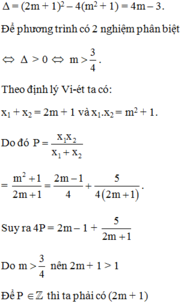Hãy nhập câu hỏi của bạn vào đây, nếu là tài khoản VIP, bạn sẽ được ưu tiên trả lời.

Δ=(-2)^2-4(m-1)
=-4m+4+4
=-4m+8
Để phương trình có hai nghiệm phân biệt thì -4m+8>0
=>-4m>-8
=>m<2
x1^2+x2^2-3x1x2=2m^2+|m-3|
=>2m^2+|m-3|=(x1+x2)^2-5x1x2=2^2-5(m-1)=4-5m+5=-5m+9
TH1: m>=3
=>2m^2+m-3+5m-9=0
=>2m^2+6m-12=0
=>m^2+3m-6=0
=>\(m\in\varnothing\)
TH2: m<3
=>2m^2+3-m+5m-9=0
=>2m^2+4m-6=0
=>m^2+2m-3=0
=>(m+3)(m-1)=0
=>m=1 hoặc m=-3

Phương trình có hai nghiệm phân biệt x1, x2 ⇔ ∆ = 52 – 4(3m + 1) > 0 ⇔ 21 – 12m > 0
ó m < 21/12
Với m < 21/12 , ta có hệ thức x 1 + x 2 = 5 x 1 x 2 = 3 m + 1 V i e t '
⇒ | x 1 − x 2 | = ( x 1 − x 2 ) 2 = ( x 1 + x 2 ) 2 − 4 x 1 x 2 = 5 2 − 4 ( 3 m + 1 ) = 21 − 12 m = > | x 1 2 − x 2 2 | = | ( x 1 + x 2 ) ( x 1 − x 2 ) | = | 5 ( x 1 − x 2 ) | = 5 | x 1 − x 2 | = 5 21 − 12 m
Ta có: | x 1 2 − x 2 2 | = 15 ⇔ 5 21 − 12 m = 15 ⇔ 21 − 12 m = 3 ⇔ 21 − 12 m = 9 ⇔ 12 m = 12 ⇔ m = 1 (t/m)
Vậy m = 1 là giá trị cần tìm

Câu a )
\(2x^4+3x^2-2=0\left(1\right)\)
Đặt \(t=x^2\left(t\ge0\right)\) phương trình (1) trở thành:
\(2t^2+3t-2=0\)
\(\Leftrightarrow t\left(2t-1\right)+4t-2=0\)
\(\Leftrightarrow t\left(2t-1\right)+2\left(2t-1\right)=0\)
\(\Leftrightarrow\left(2t-1\right)\left(t+2\right)=0\)
\(\Leftrightarrow\orbr{\begin{cases}2t-1=0\\t+2=0\end{cases}}\)
\(\Leftrightarrow\orbr{\begin{cases}t=\frac{1}{2}\\1=-2\left(loại\right)\end{cases}}\)
Với \(t=\frac{1}{2}\Leftrightarrow x^2=\frac{1}{2}\Rightarrow x=\pm\frac{\sqrt{2}}{2}\)
Vậy tập nghiệm của phương trình là \(S=\left\{\pm\frac{\sqrt{2}}{2}\right\}\)
Câu b )
\(\Delta=\left(m+1\right)^2-4m=m^2-2m+1=\left(m-1\right)^2\)
\(\Delta>0\Leftrightarrow\left(m-1\right)^2>0\Leftrightarrow m\ne1\)
\(\hept{\begin{cases}x_1+x_2=m+1\\x_1x_2=m\end{cases}}\)
\(x_1=3x_2\Rightarrow3x_2+x_2=m+1\Leftrightarrow4x_2=m+1\)
\(\Leftrightarrow x_2=\frac{m+1}{4}\Rightarrow x_1=\frac{3\left(m+1\right)}{4}\)
\(x_1x_2=m\Leftrightarrow\frac{3\left(m+1\right)^2}{16}=m\)
\(\Leftrightarrow3m^2+6m+3=16m\)
\(\Leftrightarrow3m^2-10m+3=0\)
\(\Leftrightarrow\left(3m-1\right)\left(m-3\right)=0\)
\(\Leftrightarrow\orbr{\begin{cases}m=\frac{1}{3}\\m=3\end{cases}\left(tm\right)}\)

Để pt có 2 nghiệm phân biệt thì \(\Delta>0\)
\(\Rightarrow m^2-4.1.\left(-2\right)>0\\ \Rightarrow m^2+8>0\left(luôn.đúng\right)\)
Vậy pt luôn có 2 nghiệm phân biệt
Áp dụng định lý Vi-ét ta có:\(\left\{{}\begin{matrix}x_1+x_2=-m\\x_1x_2=-2\end{matrix}\right.\)
\(x^2_1x_2+x_1x^2_2=2021\\ \Leftrightarrow x_1x_2\left(x_1+x_2\right)=2021\\ \Leftrightarrow\left(-m\right)\left(-2\right)=2021\\ \Leftrightarrow2m=2021\\ \Leftrightarrow m=\dfrac{2021}{2}\)
Để pt có 2 nghiệm thì
\(\Delta>0\\ \Rightarrow m^2-4.1.\left(-2\right)>0\\ \Rightarrow m^2+8>0.đúng.\forall.m\)
Vậy pt luôn có 2 nghiệm phân biệt
Áp dụng đlí Viét ta có
\(\left\{{}\begin{matrix}x_1+x_2=\dfrac{-b}{a}=-m\\x_1x_2=\dfrac{c}{a}=-2\end{matrix}\right.\)
Lại có
\(x_1x_2+x_1x_2=2021\\ \Rightarrow x_1x_2\left(x_1+x_2\right)< 2021\\ \Rightarrow-2\left(-m\right)=2021\Rightarrow2m=2021\\ \Rightarrow m=\dfrac{2021}{2}\)

Lời giải:
Để pt có 2 nghiệm pb thì:
$\Delta'=1-(2-m)=m-1>0\Leftrightarrow m>1$
Áp dụng định lý Viet: \(\left\{\begin{matrix} x_1+x_2=2\\ x_1x_2=2-m\end{matrix}\right.\)
Khi đó:
$2x_1^3+(m+2)x_2^2=5$
$\Leftrightarrow 2x_1^3+(2x_1+2x_2-x_1x_2)x_2^2=5$
$\Leftrightarrow 2(x_1^3+x_2^3)+x_1(2-x_2)x_2^2=5$
\(\Leftrightarrow 2[(x_1+x_2)^3-3x_1x_2(x_1+x_2)]+x_1^2x_2^2=5\)
\(\Leftrightarrow 2[8-6(2-m)]+(2-m)^2=5\)
\(\Leftrightarrow m^2+8m-9=0\Leftrightarrow (m-1)(m+9)=0\)
Vì $m>1$ nên không có giá trị nào của $m$ thỏa mãn.

a: Khi m=1 thì (1): x^2-2(1-2)x+1^2-5-4=0
=>x^2+2x-8=0
=>(x+4)(x-2)=0
=>x=2 hoặc x=-4
b: Δ=(2m-4)^2-4(m^2-5m-4)
=4m^2-16m+16-4m^2+20m+16
=4m+32
Để pt có hai nghiệm phân biệt thì 4m+32>0
=>m>-8
x1^2+x2^2=-3x1x2-4
=>(x1+x2)^2+x1x2+4=0
=>(2m-4)^2+m^2-5m-4+4=0
=>4m^2-16m+16+m^2-5m=0
=>5m^2-21m+16=0
=>(m-1)(5m-16)=0
=>m=16/5 hoặc m=1

\(\Delta=\left(-m\right)^2-2.1.\left(m-1\right)\\ =m^2-2m+1\\ =\left(m-1\right)^2\)
Phương trình có hai nghiệm phân biệt :
\(\Leftrightarrow\Delta>0\\ \Rightarrow\left(m-1\right)^2>0\\ \Rightarrow m\ne1\)
Theo vi ét :
\(\Leftrightarrow\left\{{}\begin{matrix}x_1+x_2=m\\x_1x_2=m-1\end{matrix}\right.\)
\(x^2_1+x^2_2=x_1+x_2\\ \Leftrightarrow x^2_1+x^2_2=m\\ \Leftrightarrow\left(x^2_1+2x_1x_2+x_2^2\right)-2x_1x_2=m\\ \Leftrightarrow\left(x_1+x_2\right)^2-2x_1x_2-m=0\\ \Leftrightarrow m^2-2\left(m-1\right)-m=0\\ \Leftrightarrow m^2-2m+2-m=0\\ \Leftrightarrow m^2-3m+2=0\\ \Leftrightarrow\left[{}\begin{matrix}m=1\left(loại\right)\\m=2\left(t/m\right)\end{matrix}\right.\)
Vậy \(m=2\)



1:
Δ=(-6)^2-4*2*m=36-8m
Để phương trình có hai nghiệm phân biệt thì -8m+36>0
=>m<9/2
x1/x2+x2/x1=3
=>(x1^2+x2^2)/(x1x2)=3
=>[3^2-2*m/2]/(m/2)=3
=>9-m=3m/2
=>9=5m/2
=>m=9:5/2=9*2/5=18/5(nhận)
6:
Gọi thời gian anh Tâm hoàn thành công việc khi làm một mình là x
=>Thời gian anh Trí hoàn thành công việc khi làm một mình là x+2
Theo đề, ta có: 1/x+1/x+2=1:4/3=3/4
=>(x+2+x)/(x^2+2x)=3/4
=>3x^2+6x=8x+8
=>x=2